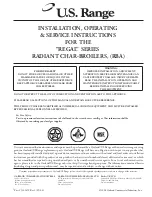
Part # 1382692 Rev 2 (09/04)
Page 6
Prior to connecting the regulator, check the incoming line
pressure, as these regulators can withstand a maximum
pressure of 1/2 psi (14” WC). If the Line pressure is
beyond this limit, a step-down regulator will be required.
Double-check the arrow forged onto the bottom of the
regulator body which shows gas flow directions; it should
point downstream to the appliance. The red air-vent cap
is part of the regulator and should not be removed unless
local codes require external venting.
Regulators can be adjusted in the field, but it is
recommended that they not be tampered with unless
that part is known to be out of adjustment or serious
pressure fluctuations are found to exist and can be solved
no other way. Any adjustments to regulators must be
made by qualified service personnel with proper test
equipment.
If a vent line from the gas appliance pressure regulator is
used, it should be installed to the outdoors in accordance
with local codes or code ANSI Z223.1, Natural Gas
Installation code, CAN/CGA-B149.1, or The Propane
Installation code, CAN/CGA-B149.2.
WARNING Failure to install a pressure regulator will
void the equipment warranty!
Rigid Connections
Double-check any installer-supplied intake pipes visually
and clear any dirt particles, threading chips, or other
foreign matter before installing in a service line. Those
particles will clog orifices when gas pressure is applied.
WARNING All connections must be sealed with a
joint compound suitable for LP gas, and all connections
must be tested with a soapy solution before lighting
any pilots!
Flexible Couplings & Connectors.
If the unit is to be installed with flexible couplings and/or
quick disconnect fittings, the installer must use an AGA
design-certified commercial flexible connector or at least
INSTALLATION Continued
3/4” NPT (with suitable strain relief’s) in compliance
with the Standard for Connectors for Movable Gas
Appliances, ANSI Z21.89, or CAN/CGA-6.16. Quick
disconnect devices must comply with the Standard for
Quick Disconnect Devices for use with Gas Fuel, ANSI
Z21.41, or CAN/CGA-6.0 Domestic connectors are not
suitable!
Manual Pilot Valve
All burners are equipped with constant-burning pilots.
These should be manually lighted immediately after the
gas is turned on and the system is checked for leaks.
Pilots can be reached with a long match or taper down
from the top if the grates and radiants have not yet
been installed, or through the observation/adjustment
openings in the valve cover between the burner valve
knobs. These openings also contain the pilot valves,
which are screwdriver adjustable.
Testing and Adjustments
Check all gas connections for leaks using a soapy solution
before lighting any pilots. DO NOT USE OPEN FLAME
TO CHECK FOR LEAKS! Putting open flame beside
a new connection is not only dangerous, but will often
miss small leaks that a soapy solution would find.
All U.S. Range appliances are adjusted and tested before
leaving the factory, effectively matching them to sea
level conditions. Adjustments and calibrations to assure
proper operation may be necessary on installation to meet
local conditions, low gas pressure, differences in altitude;
variations in gas characteristics, to correct possible
problems caused by rough handling or vibration during
shipment, and are to be performed only by qualified
service personnel.
These adjustments are the responsibility of the customer,
installer and/or dealer and are not covered by the U.S.
Range warranty.
Содержание "REGAL" SERIES
Страница 9: ...Part 1382692 Rev 2 09 04 Page 9 NOTES...
Страница 10: ...Part 1382692 Rev 2 09 04 Page 10 NOTES...
Страница 11: ...Part 1382692 Rev 2 09 04 Page 11 NOTES...
Страница 12: ......






























